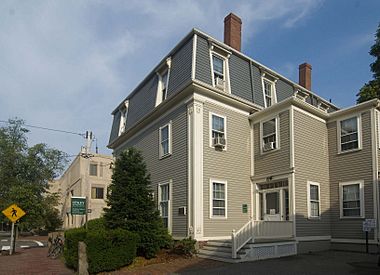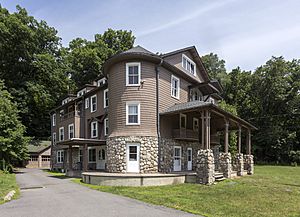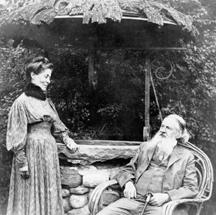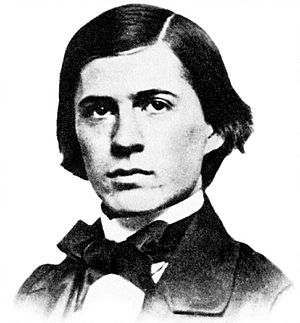Charles Sanders Peirce facts for kids
Quick facts for kids
Charles Sanders Peirce
|
|
|---|---|
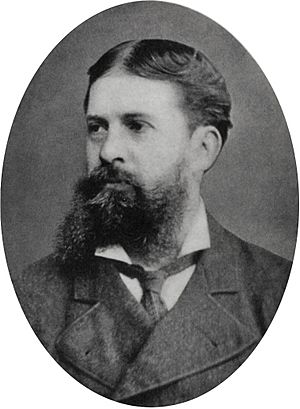 |
|
| Born | September 10, 1839 Cambridge, Massachusetts, U.S.
|
| Died | April 19, 1914 (aged 74) Milford, Pennsylvania, U.S.
|
| Alma mater | Harvard University |
| Era | Late modern philosophy |
| Region | Western philosophy |
| School | Pragmatism Pragmaticism |
| Institutions | Johns Hopkins University |
| Notable students |
List
|
|
Main interests
|
|
|
Influences
|
|
| Signature | |
Charles Sanders Peirce (/pɜːrs/ purss; September 10, 1839 – April 19, 1914) was an American philosopher, logician, mathematician and scientist. He is sometimes called "the father of pragmatism".
Peirce made major contributions to logic. He is known as the founder of semiotics, a study of the meaning of language, signs and symbols. As early as 1886, he saw that logical operations could be carried out by electrical switching circuits. The same idea was used decades later to produce digital computers.
Peirce's most important work in pure mathematics was in logical and foundational areas. He also worked on linear algebra, matrices, various geometries, topology and Listing numbers, Bell numbers, graphs, the four-color problem, and the nature of continuity.
In 1934, the philosopher Paul Weiss called Peirce "the most original and versatile of American philosophers and America's greatest logician".
Contents
Early life and education
Peirce was born at 3 Phillips Place in Cambridge, Massachusetts. He was the son of Sarah Hunt Mills and Benjamin Peirce, himself a professor of astronomy and mathematics at Harvard University.
He earned a Bachelor of Arts degree and a Master of Arts degree (1862) from Harvard. In 1863 the Lawrence Scientific School awarded him a Bachelor of Science degree.
At Harvard, he began lifelong friendships with Francis Ellingwood Abbot, Chauncey Wright, and William James. One of his Harvard instructors, Charles William Eliot, formed an unfavorable opinion of Peirce. This proved fateful, because Eliot, while President of Harvard (1869–1909—a period encompassing nearly all of Peirce's working life), repeatedly vetoed Peirce's employment at the university.
Peirce suffered from his late teens onward from a nervous condition then known as "facial neuralgia", which would today be diagnosed as trigeminal neuralgia. His biographer, Joseph Brent, says that when in the throes of its pain "he was, at first, almost stupefied, and then aloof, cold, depressed, extremely suspicious, impatient of the slightest crossing, and subject to violent outbursts of temper". Its consequences may have led to the social isolation of his later life.
Early employment
Between 1859 and 1891, Peirce was employed by the United States Coast Survey and its successor, the United States Coast and Geodetic Survey, where he worked mainly in geodesy and gravimetry, refining the use of pendulums to determine small local variations in the Earth's gravity. That employment exempted Peirce from having to take part in the American Civil War.
The Survey sent him to Europe five times, first in 1871 as part of a group sent to observe a solar eclipse. From 1869 to 1872, he was employed as an assistant in Harvard's astronomical observatory, doing important work on determining the brightness of stars and the shape of the Milky Way. On April 20, 1877, he was elected a member of the National Academy of Sciences. Also in 1877, he proposed measuring the meter as so many wavelengths of light of a certain frequency, the kind of definition employed from 1960 to 1983.
During 1883–1909, Peirce wrote entries on philosophy, logic, science, and other subjects for the encyclopedic Century Dictionary. In 1891, he resigned from the Coast Survey.
Johns Hopkins University
In 1879, Peirce was appointed lecturer in logic at Johns Hopkins University. His Studies in Logic by Members of the Johns Hopkins University (1883) contained works by himself and Allan Marquand, Christine Ladd, Benjamin Ives Gilman, and Oscar Howard Mitchell, several of whom were his graduate students. Peirce's nontenured position at Hopkins was the only academic appointment he ever held.
Peirce's personal life worked against his professional success. After his first wife, Harriet Melusina Fay ("Zina"), left him in 1875, Peirce, while still legally married, became romantically involved with Juliette, whose last name remains uncertain. The fact that he had lived with a woman to whom he was not married led to a scandal that resulted in his dismissal in January 1884. Over the years Peirce sought academic employment at various universities without success.
When his divorce from Zina became final, he married Juliette. He had no children by either marriage.
Later years
In 1887, Peirce spent part of his inheritance from his parents to buy 2,000 acres (8 km2) of rural land near Milford, Pennsylvania, which never yielded an economic return. There he had an 1854 farmhouse remodeled to his design. The Peirces named the property "Arisbe". There they lived with few interruptions for the rest of their lives, Charles writing prolifically, much of it unpublished to this day (see Works). Living beyond their means soon led to grave financial and legal difficulties. An outstanding warrant for assault and unpaid debts led to his being a fugitive in New York City for a while. Several people, including his brother James Mills Peirce and his neighbors, relatives of Gifford Pinchot, settled his debts and paid his property taxes and mortgage.
Peirce did some scientific and engineering consulting and wrote much for meager pay, mainly encyclopedic dictionary entries, and reviews for The Nation. He also did translations for the Smithsonian Institution. Peirce did substantial mathematical calculations for Langley's research on powered flight. Hoping to make money, Peirce tried inventing. He began but did not complete several books. In 1888, President Grover Cleveland appointed him to the Assay Commission.
From 1890 on, he had a friend and admirer in Judge Francis C. Russell of Chicago, who introduced Peirce to editor Paul Carus and owner Edward C. Hegeler of the pioneering American philosophy journal The Monist, which eventually published at least 14 articles by Peirce. He wrote many texts in James Mark Baldwin's Dictionary of Philosophy and Psychology (1901–1905).
The one who did the most to help Peirce in these desperate times was his old friend William James, dedicating his Will to Believe (1897) to Peirce, and arranging for Peirce to be paid to give two series of lectures at or near Harvard (1898 and 1903). Most important, each year from 1907 until James's death in 1910, James wrote to his friends in the Boston intelligentsia to request financial aid for Peirce; the fund continued even after James died. Peirce reciprocated by designating James's eldest son as his heir should Juliette predecease him.
Death
Peirce died destitute in Milford, Pennsylvania, twenty years before his widow. Juliette Peirce kept the urn with Peirce's ashes at Arisbe. In 1934, Pennsylvania Governor Gifford Pinchot arranged for Juliette's burial in Milford Cemetery. The urn with Peirce's ashes was interred with Juliette.
Works
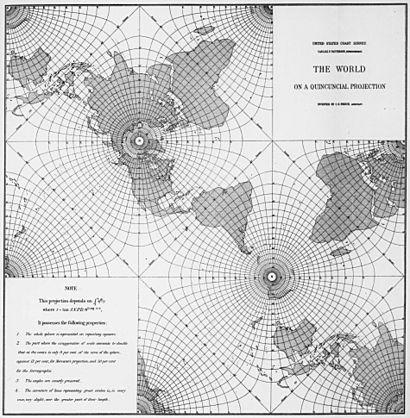
Peirce's reputation rests largely on academic papers published in American scientific and scholarly journals. The only full-length book that Peirce authored and saw published in his lifetime was Photometric Researches (1878), a 181-page monograph on the applications of spectrographic methods to astronomy. While at Johns Hopkins, he edited Studies in Logic (1883), containing chapters by himself and his graduate students. Besides lectures during his years (1879–1884) as lecturer in Logic at Johns Hopkins, he gave at least nine series of lectures, many now published; see Lectures by Peirce.
After Peirce's death, Harvard University obtained from Peirce's widow the papers found in his study, but did not microfilm them until 1964. Only after Richard Robin (1967) catalogued this Nachlass did it become clear that Peirce had left approximately 1,650 unpublished manuscripts, totaling over 100,000 pages, mostly still unpublished except on microfilm. Reportedly the papers remain in unsatisfactory condition.
The first published anthology of Peirce's articles was the one-volume Chance, Love and Logic: Philosophical Essays, edited by Morris Raphael Cohen, 1923, still in print. Other one-volume anthologies were published in 1940, 1957, 1958, 1972, 1994, and 2009, most still in print. The main posthumous editions of Peirce's works in their long trek to light, often multi-volume, and some still in print, have included:
1931–1958: Collected Papers of Charles Sanders Peirce (CP), 8 volumes, includes many published works, along with a selection of previously unpublished work and a smattering of his correspondence. This long-time standard edition drawn from Peirce's work from the 1860s to 1913 remains the most comprehensive survey of his prolific output from 1893 to 1913. It is organized thematically, but texts (including lecture series) are often split up across volumes, while texts from various stages in Peirce's development are often combined, requiring frequent visits to editors' notes. Edited (1–6) by Charles Hartshorne and Paul Weiss and (7–8) by Arthur Burks, in print and online.
1975–1987: Charles Sanders Peirce: Contributions to The Nation, 4 volumes, includes Peirce's more than 300 reviews and articles published 1869–1908 in The Nation. Edited by Kenneth Laine Ketner and James Edward Cook, online.
1976: The New Elements of Mathematics by Charles S. Peirce, 4 volumes in 5, included many previously unpublished Peirce manuscripts on mathematical subjects, along with Peirce's important published mathematical articles. Edited by Carolyn Eisele, back in print.
1977: Semiotic and Significs: The Correspondence between C. S. Peirce and Victoria Lady Welby (2nd edition 2001), included Peirce's entire correspondence (1903–1912) with Victoria, Lady Welby. Peirce's other published correspondence is largely limited to the 14 letters included in volume 8 of the Collected Papers, and the 20-odd pre-1890 items included so far in the Writings. Edited by Charles S. Hardwick with James Cook, out of print.
1982–now: Writings of Charles S. Peirce, A Chronological Edition (W), Volumes 1–6 & 8, of a projected 30. The limited coverage, and defective editing and organization, of the Collected Papers led Max Fisch and others in the 1970s to found the Peirce Edition Project (PEP), whose mission is to prepare a more complete critical chronological edition. Only seven volumes have appeared to date, but they cover the period from 1859 to 1892, when Peirce carried out much of his best-known work. Writings of Charles S. Peirce, 8 was published in November 2010; and work continues on Writings of Charles S. Peirce, 7, 9, and 11. In print and online.
1985: Historical Perspectives on Peirce's Logic of Science: A History of Science, 2 volumes. Auspitz has said, "The extent of Peirce's immersion in the science of his day is evident in his reviews in the Nation [...] and in his papers, grant applications, and publishers' prospectuses in the history and practice of science", referring latterly to Historical Perspectives. Edited by Carolyn Eisele, back in print.
1992: Reasoning and the Logic of Things collects in one place Peirce's 1898 series of lectures invited by William James. Edited by Kenneth Laine Ketner, with commentary by Hilary Putnam, in print.
1992–1998: The Essential Peirce (EP), 2 volumes, is an important recent sampler of Peirce's philosophical writings. Edited (1) by Nathan Hauser and Christian Kloesel and (2) by Peirce Edition Project editors, in print.
1997: Pragmatism as a Principle and Method of Right Thinking collects Peirce's 1903 Harvard "Lectures on Pragmatism" in a study edition, including drafts, of Peirce's lecture manuscripts, which had been previously published in abridged form; the lectures now also appear in The Essential Peirce, 2. Edited by Patricia Ann Turisi, in print.
2010: Philosophy of Mathematics: Selected Writings collects important writings by Peirce on the subject, many not previously in print. Edited by Matthew E. Moore, in print.
Discoveries
Peirce made a number of striking discoveries in formal logic and foundational mathematics, nearly all of which came to be appreciated only long after he died.
In 1860 he suggested a cardinal arithmetic for infinite numbers, years before any work by Georg Cantor.
In 1880–1881 he showed how Boolean algebra could be done via a repeated sufficient single binary operation (logical NOR), anticipating Henry M. Sheffer by 33 years.
In 1881 he set out the axiomatization of natural number arithmetic, a few years before Richard Dedekind and Giuseppe Peano. In the same paper Peirce gave, years before Dedekind, the first purely cardinal definition of a finite set in the sense now known as "Dedekind-finite", and implied by the same stroke an important formal definition of an infinite set (Dedekind-infinite), as a set that can be put into a one-to-one correspondence with one of its proper subsets.
In 1885 he distinguished between first-order and second-order quantification. In the same paper he set out what can be read as the first (primitive) axiomatic set theory, anticipating Zermelo by about two decades (Brady 2000, pp. 132–33).
In 1886, he saw that Boolean calculations could be carried out via electrical switches, anticipating Claude Shannon by more than 50 years.
Interesting facts about Charles Sanders Peirce
- At age 12, Charles read his older brother's copy of Richard Whately's Elements of Logic, then the leading English-language text on the subject. So began his lifelong fascination with logic and reasoning.
- Peirce learned philosophy mainly by reading, each day, a few pages of Immanuel Kant's Critique of Pure Reason, in the original German, while a Harvard undergraduate.
- He worked on applied mathematics in economics, engineering, and map projections, and was especially active in probability and statistics.
- Peirce was one of the founders of statistics.
- In his "F.R.L." (First Rule of Logic) (1899), Peirce states that the first, and "in one sense, the sole", rule of reason is that, to learn, one needs to desire to learn.
- Peirce spent much of his last two decades unable to afford heat in winter and subsisting on old bread donated by the local baker.
- Unable to afford new stationery, he wrote on the verso side of old manuscripts.
See also
 In Spanish: Charles Sanders Peirce para niños
In Spanish: Charles Sanders Peirce para niños
- Howland will forgery trial
- Hypostatic abstraction
- Charles Sanders Peirce § Notes
- Laws of Form
- List of American philosophers
- Logical machine
- Logical matrix
- Mathematical psychology
- Charles Sanders Peirce § Notes
- Peircean realism
- Pragmatics
- Charles Sanders Peirce § Notes
- Charles Sanders Peirce § Notes
- Relation algebra
- Truth table
Contemporaries associated with Peirce


